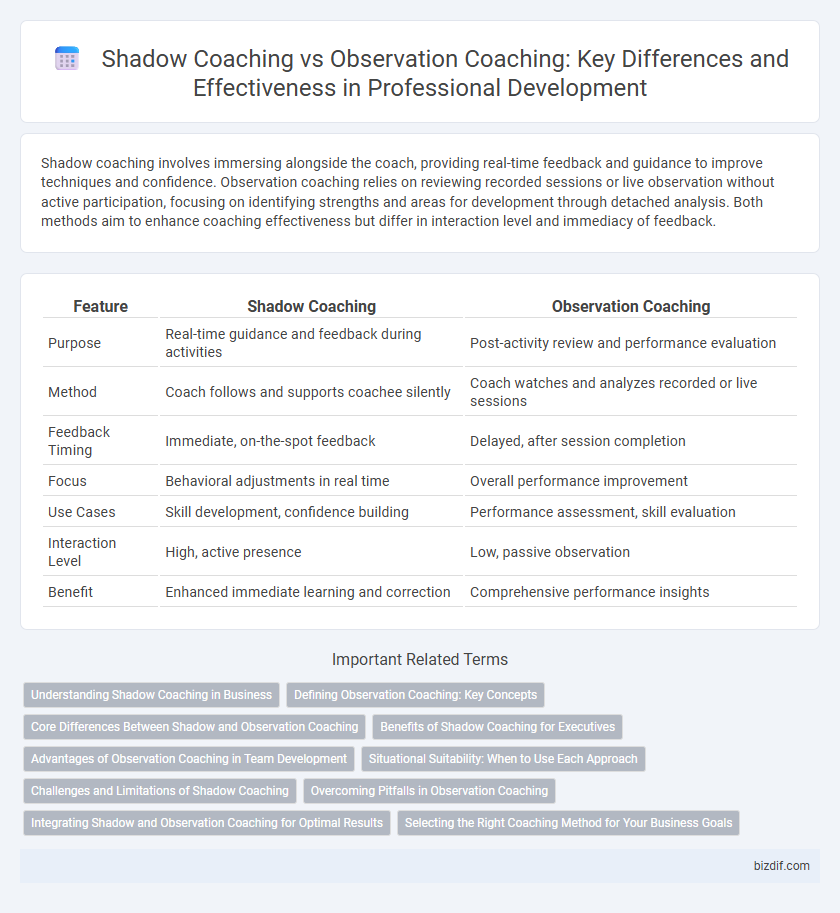Shadow coaching involves immersing alongside the coach, providing real-time feedback and guidance to improve techniques and confidence. Observation coaching relies on reviewing recorded sessions or live observation without active participation, focusing on identifying strengths and areas for development through detached analysis. Both methods aim to enhance coaching effectiveness but differ in interaction level and immediacy of feedback.
Table of Comparison
| Feature | Shadow Coaching | Observation Coaching |
|---|---|---|
| Purpose | Real-time guidance and feedback during activities | Post-activity review and performance evaluation |
| Method | Coach follows and supports coachee silently | Coach watches and analyzes recorded or live sessions |
| Feedback Timing | Immediate, on-the-spot feedback | Delayed, after session completion |
| Focus | Behavioral adjustments in real time | Overall performance improvement |
| Use Cases | Skill development, confidence building | Performance assessment, skill evaluation |
| Interaction Level | High, active presence | Low, passive observation |
| Benefit | Enhanced immediate learning and correction | Comprehensive performance insights |
Understanding Shadow Coaching in Business
Shadow coaching immerses coaches directly into real-time business environments, allowing them to observe leaders' behaviors and decision-making processes firsthand. This method captures authentic interactions and contextual challenges that may be overlooked in traditional observation coaching conducted remotely or through recorded sessions. By linking insights to actual workplace dynamics, shadow coaching facilitates tailored development strategies that enhance leadership effectiveness and organizational performance.
Defining Observation Coaching: Key Concepts
Observation coaching involves a coach systematically watching a client's performance to identify strengths and areas for improvement, often using direct feedback and video analysis. It emphasizes real-time assessment and reflection to enhance skills and behavior through detailed, objective data collection. This method contrasts with shadow coaching by prioritizing structured observation over accompanying the client throughout their activities.
Core Differences Between Shadow and Observation Coaching
Shadow coaching involves the coach actively participating alongside the coachee to provide real-time feedback and guidance, enhancing immediate skill development. Observation coaching, by contrast, centers on the coach silently monitoring the coachee's performance, followed by a detailed analysis and constructive feedback session. Core differences include the level of coach engagement during activities and the timing of feedback delivery.
Benefits of Shadow Coaching for Executives
Shadow coaching offers executives personalized, real-time feedback by closely observing their interactions and decision-making processes in authentic work settings. This immersive approach enhances self-awareness, improves leadership skills, and fosters immediate behavioral adjustments essential for effective executive performance. Executives benefit from tailored guidance that aligns with their unique challenges, driving sustained professional growth and organizational impact.
Advantages of Observation Coaching in Team Development
Observation coaching enhances team development by providing real-time insights into group dynamics and individual contributions, enabling targeted feedback that fosters collaborative improvement. Unlike shadow coaching, observation coaching captures authentic interactions, promoting transparency and trust within the team. This method accelerates skill acquisition and alignment with organizational goals through actionable, evidence-based guidance.
Situational Suitability: When to Use Each Approach
Shadow coaching proves most effective in dynamic, client-facing environments where real-time feedback enhances skill development, such as sales or leadership roles. Observation coaching suits structured settings like workshops or training sessions where deliberate practice and reflective feedback optimize learning outcomes. Selecting the appropriate method depends on the immediacy of feedback needed and the complexity of the situational interactions involved.
Challenges and Limitations of Shadow Coaching
Shadow coaching often faces challenges such as limited real-time feedback and potential biases due to the coach's close involvement in the coachee's environment. Unlike observation coaching, which allows for more detached and objective analysis, shadow coaching may hinder open communication if the coachee feels constantly monitored. These limitations can impact the effectiveness of behavior change and skill development during coaching sessions.
Overcoming Pitfalls in Observation Coaching
Overcoming pitfalls in observation coaching requires addressing issues such as bias, limited context, and lack of real-time feedback that can hinder accurate assessment. Shadow coaching mitigates these challenges by enabling coaches to engage more deeply with coachees, fostering trust and gaining insights through continuous, immersive support. Emphasizing reflective dialogue and active listening during shadow coaching enhances learning outcomes and reduces misinterpretations common in traditional observation methods.
Integrating Shadow and Observation Coaching for Optimal Results
Integrating shadow coaching with observation coaching creates a comprehensive development approach by combining real-time feedback during live interactions with reflective analysis of recorded sessions. Shadow coaching allows coaches to capture authentic behavior patterns and contextual nuances, while observation coaching offers structured insights through detailed review and assessment. Leveraging both methods enhances skill acquisition, fosters deeper self-awareness, and drives sustained performance improvement.
Selecting the Right Coaching Method for Your Business Goals
Shadow coaching provides immersive, real-time feedback by observing actual interactions, enabling personalized skill development aligned with specific business objectives. Observation coaching offers a structured review through recorded or live sessions, facilitating objective analysis and targeted improvements. Selecting the right method depends on your business goals, whether prioritizing immediate behavioral adjustments or comprehensive performance evaluation for long-term growth.
Shadow coaching vs observation coaching Infographic

 bizdif.com
bizdif.com